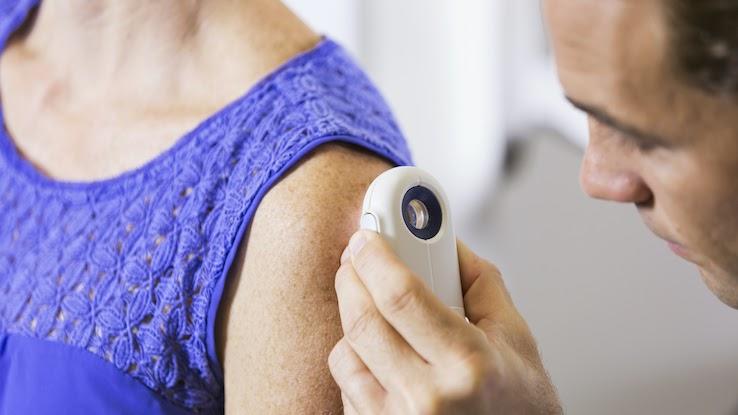Skin Cancer Palm Beach Gardens

According to the American Cancer Society, just over 100,000 new cases of skin cancer are diagnosed in the United States each year. The strongest risk factor for developing skin cancer is ultraviolet (UV) ray exposure, typically from the sun.
While skin cancer often affects older adults because they've spent more time in the sun during their lives, the last several decades have seen a rising number of cases in younger people. Some researchers believe this increase has happened because of the growing use of indoor tanning beds. People are also exposed to cancer-causing ingredients in common products more often today than in decades past.
Although skin cancer can develop anywhere on your body, it most commonly forms on areas that get the most sun — including your face. Learning about the common signs and symptoms of facial skin cancer can empower you to take charge of your health and recognize when it's time to see a doctor.
Characteristics of Skin Cancer Lesions
The sores, or lesions, that skin cancer can cause have several common characteristics. One easy way to remember them is to think of the first five letters of the alphabet, as follows:
- "A" for asymmetrical. A cancerous lesion may show up as a mole or freckle with an asymmetrical, or uneven, shape.
- "B" for border. The border of a cancerous lesion will often be irregular, or not smooth.
- "C" for color. You should monitor your moles and freckles for changes in color or coloring that looks uneven.
- "D" for diameter. The diameter of a mole or freckle can give you or your doctor information about whether it might be cancerous. If you have moles larger than the size of a pea, or you have a mole that's increasing in size, have your doctor take a look at the mole.
- "E" for evolving. Make sure you regularly check your moles and freckles for signs of changes in size, color and texture.
Signs and Symptoms to Watch Out For

In addition to the characteristics above that you'll want to pay attention to, facial skin cancer has several common signs and symptoms. If you notice any of the following signs and symptoms, make an appointment with your doctor for an evaluation:
- Red, scaly skin. Basal cell carcinoma and squamous cell carcinoma are two of the most common types of skin cancer. Both may appear as a patch of red skin with scaly flakes or reddish crust. You might initially mistake these patches for dry skin, psoriasis or another skin condition. Skin cancer, however, typically persists even after you try treating it with topical creams meant for skin conditions like acne or dryness. If you have fair skin, light-colored eyes or a family history of skin cancer, you're particularly at risk. You should see a dermatologist right away if you develop this symptom.
- Sores. Although a variety of injuries can cause sores, if you develop one that suddenly appears without an apparent cause, let your doctor know right away. Sores that don't heal are a common symptom of skin cancer. Cancerous sores can vary in size, and they may ooze or bleed. The sore may appear to scab or heal for a little while, only to reopen and bleed again.
- Bumps or irregularly textured skin. Skin cancer can show up on your skin in a variety of colors and sizes. Lumps that appear suddenly and are hard and red may be symptoms of squamous cell carcinoma. Basal cell carcinoma often appears as a slightly raised bump that has a waxy or pearly texture. Sometimes, these take the form of a flat, scar-like area instead of a raised lump. A small, horn-like growth of hardened skin can also occasionally be a symptom of facial skin cancer.
- Changes in lip texture or color. Lips are a common site for facial skin cancers. But the changes cancer causes when it appears on your lips can be subtle. One common sign is actinic cheilitis, which causes rough, red or scaly patches on your lips. Some of this is normal as part of dry skin, but potentially cancerous changes are persistent and resistant to treatment. Sometimes this symptom is paired with swelling, prominent lip lines or a blending of your lip color with the skin around it.
- Changes in moles, freckles or spots. Melanoma is the least common type of skin cancer, but it's the deadliest. The most common warning sign of facial melanoma is a sudden change in your moles or freckles. Cancerous moles are usually asymmetrical, while benign (harmless) moles are round. Cancerous spots also often have a variety of colors, and they may bleed or crust over. Moles that were previously benign but begin to get larger or otherwise change may also be an early warning sign of skin cancer. See a dermatologist if you develop any new moles or pigmented splotches or if you experience rapid changes in your existing moles or freckles.
Skin cancer can be life-threatning. But, it's easily treatable if your doctor diagnoses it early enough. It's essential to know the early warning signs and symptoms of skin cancer — it may save your life one day.
Resource Links:
"Skin Cancer," Cancer Quest
"About Melanoma," Melanoma Research Alliance
"What Melanoma Looks Like," Melanoma Research Foundation
"What Are the Symptoms of Skin Cancer?," Centers for Disease Control and Prevention
"What are the Symptoms and Signs of Skin Cancer?," Cancer Treatment Centers of America
"Basal Cell Carcinoma Warning Signs and Images – The Skin Cancer Foundation," Skin Cancer Foundation
"Basal and Squamous Cell Skin Cancer | Non-melanoma Skin Cancer," American Cancer Society
Source: https://www.symptomfind.com/healthy-living/warning-signs-facial-skin-cancer?utm_content=params%3Ao%3D740013%26ad%3DdirN%26qo%3DserpIndex
0 Response to "Skin Cancer Palm Beach Gardens"
إرسال تعليق